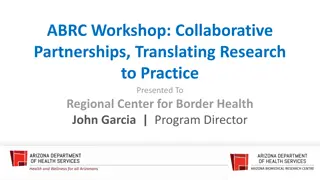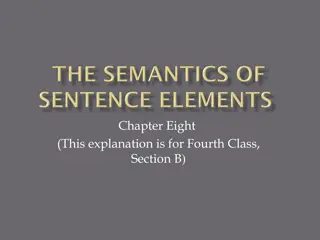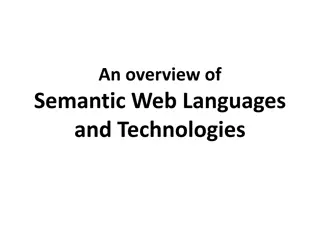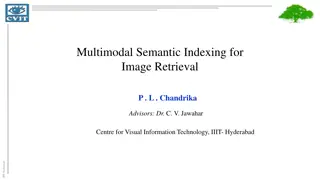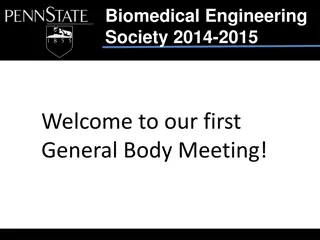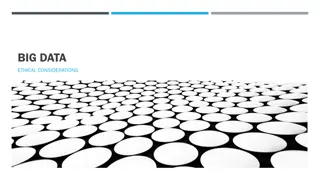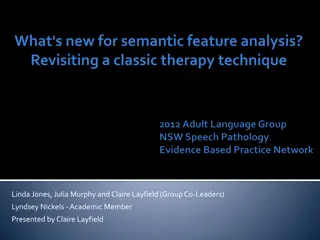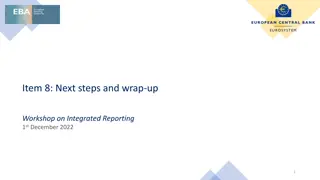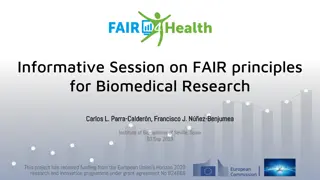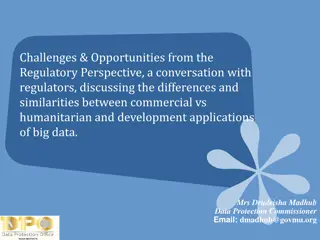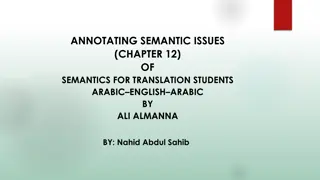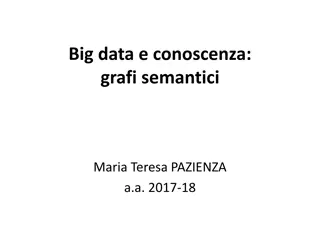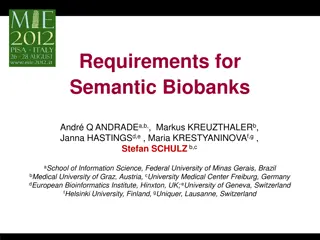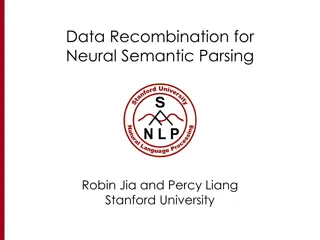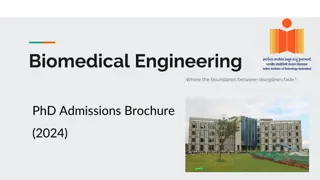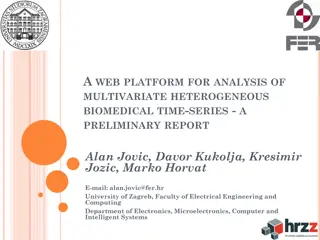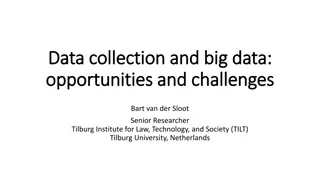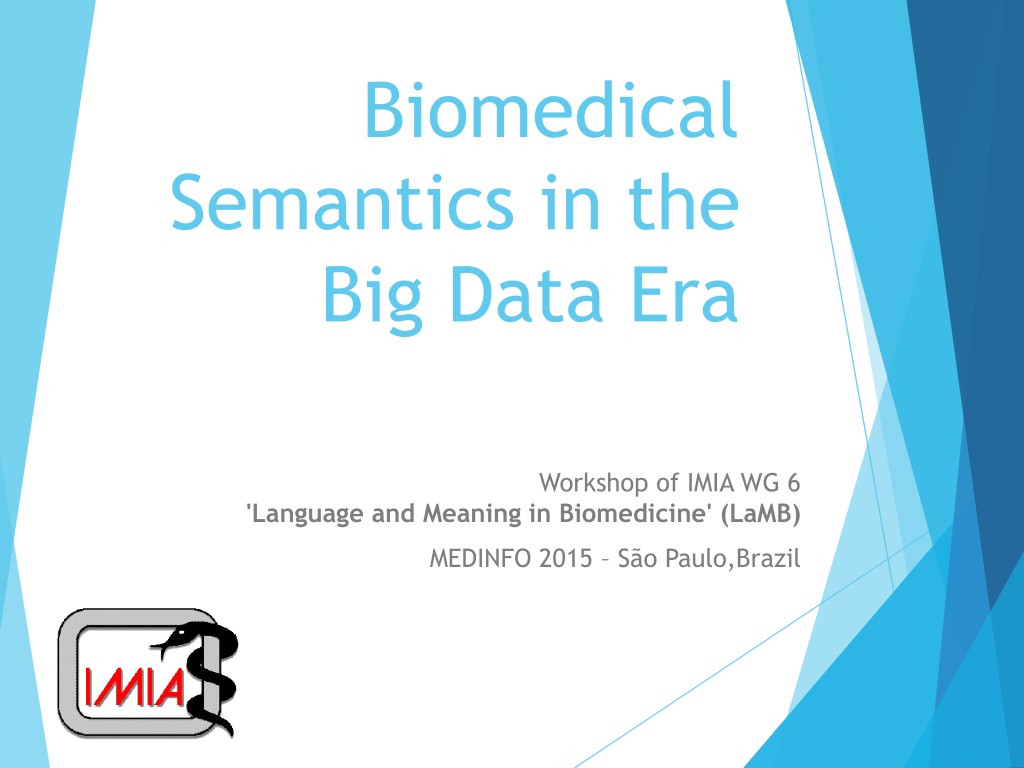
Semantics in Biomedical Big Data Era Workshop
Discover insights from the Biomedical Semantics in the Big Data Era workshop at IMIA WG 6's Language and Meaning in Biomedicine event. Explore topics such as ontology development, knowledge representation, and biomedical decision support. Gain valuable knowledge from speakers like Tomasz Adamusiak, Ronald Cornet, Jianying Hu, and more.
Download Presentation

Please find below an Image/Link to download the presentation.
The content on the website is provided AS IS for your information and personal use only. It may not be sold, licensed, or shared on other websites without obtaining consent from the author. Download presentation by click this link. If you encounter any issues during the download, it is possible that the publisher has removed the file from their server.
E N D
Presentation Transcript
Biomedical Semantics in the Big Data Era Workshop of IMIA WG 6 'Language and Meaning in Biomedicine' (LaMB) MEDINFO 2015 S o Paulo,Brazil
Speakers Tomasz Adamusiak (Thomson Reuters, Boston, MA, USA) Ronald Cornet (Academic Medical Center University of Amsterdam, Amsterdam, The Netherlands & Link ping University, Link ping, Sweden) Jianying Hu (IBM T. J. Watson Research Center, Yorktown Heights, NY, USA) Comment Stefan: I removed academic degrees because of difficult comparability across countries Stephane Meystre (University of Utah, Salt Lake City, Utah, USA) Patrick Ruch (University of Applied Sciences Western Switzerland, Geneva, Switzerland) Stefan Schulz (Medical University of Graz, Graz, Austria)
Agenda Introduction Ronald Cornet 1. From free text to ontology Stephane Meystre 2. Bridging natural and formal languages for representing knowledge and information Stefan Schulz 3. Deep question-answering for biomedical decision support Patrick Ruch 4. Feature extraction for predictive modeling Jianying Hu 5. Semantic technology for knowledge discovery Tomasz Adamusiak Overall discussion all Round-up
Topics to be discussed Applying ontological realism to medically unexplained syndromes Automated Concept and Relationship Extraction for Ontology Development Automated concept and relationship extraction for the Semi-Automated Ontology Management (SEAM) System Automatic mapping of clinical documentation to SNOMED CT Care pathway workbench: evidence harmonization from guideline and data Closing the loop: from paper to protein annotation using supervised Gene Ontology classification Combining knowledge and data driven insights for identifying risk factors using electronic health records EHR-based phenome wide association study in pancreatic cancer Exploring Patient Risk Groups with Incomplete Knowledge Formal ontologies in biomedical knowledge representation Intra-Axiom Redundancies in SNOMED CT Literature Review of SNOMED CT Use Managing the data deluge: data-driven GO category assignment improves while complexity of functional annotation increases Next Generation Phenotyping Using the Unified Medical Language System Quality assurance in LOINC using description logic Question answering for biology and medicine Subword-based semantic retrieval of clinical and bibliographic documents User-Directed Coordination in SNOMED CT
Key Concepts Algorithms Artificial Intelligence Linguistics Logic Logical Observation Identifiers Names and Codes Meaningful Use Medical Informatics Medical Informatics Applications medical record Medical Record Linkage Automatic Data Processing Bayes Bibliometrics Biological Ontologies Biological Science Disciplines Biology Case Management Classification Computational Biology Computer Systems Computers Critical Pathways Current Procedural Terminology data Data Collection Data Mining Databases, Bibliographic Databases, Genetic Medical Records Systems, Computerized Medicine MEDLINE Molecular Sequence Annotation Multilingualism Natural Language Processing predictive model Programming Languages Publishing PubMed Quality Control Quality Improvement Decision Support Systems, Clinical Decision Support Techniques Documentation Electronic Health Records Gene Ontology RISk Group Analysis ROC Curve RxNorm Science Search Engine Healthcare Common Procedure Coding System Information Science Semantics Software Information Storage and Retrieval system process Information Systems Intelligence Systematized Nomenclature of Medicine Systems Biology International Classification of Diseases knowledge Knowledge Bases Language Terminology as Topic Unified Medical Language System Vocabulary, Controlled Workflow
Biomedical Semantics in the Big Data Era Stefan Schulz Bridging natural and formal languages for representing knowledge and information Workshop of IMIA WG 6 'Language and Meaning in Biomedicine' (LaMB) MEDINFO 2015 S o Paulo,Brazil
The promise of Big Data (?) "Today companies like Google, which have grown up in an era of massively abundant data, don't have to settle for wrong models. Indeed, they don't have to settle for models at all. (...) Forget taxonomy, ontology, and psychology." Chris Anderson Wired Magazine, 2008
The rise of semantic standards and specifications Ontologies Terminologies Information Models UMLS
Standardised representation and reasoning formalisms ObservationResult and isAboutQuality only (MassIntake and inheresIn some CigaretteTobaccoSmokingSituation and projectsOnto some (ValueRegion and isRepresentedBy only (hasInformationAttribute some perDay and hasValue some int[>=10]))) SubClassOf InformationItem and isAboutSituation HeavyCigaretteTobacco Situation
Persistence of free text narratives in EHRs Patient is a 80 y/o female with hx of CAD, DM, HTN, left PICA stroke who presented to the ED after a fall. SHe was admitted after being found to be demented and unclear if this was a new or old diagnosis. Basic labs for dementia were sent including TSH, B12, folate which were normal. MRI revealed a mennigioma and old PICA infarct. Likely diagnosis is Alzheimer's Disease. She was started on donepezil and Quetiapine. PT/OT evaluated her and felt that she was safe to be d/c home with services.
Persistence of data silos: No interoperability CIS 3 English Texts CIS 4 Spanish Texts CIS 2 Termi nology Y CIS 1 Terminology X Proprietary vocabularies / data dictionaries Proprietary information templates Different natural languages Legacy systems that obviate data exchange
Barriers to Semantic Interoperability Vocabularies, ontologies, information models: Conflicting and overlapping models of meaning and use Lack of ontological grounding Confuse and ambiguous naming Representation and reasoning mechanisms Difficult to learn and to apply Performance issues, computational complexity Lack of industry-standard tools Natural language content Idiosyncratic language (abbreviated, ungrammatical) Context dependence
The vision of Semantic Big Data Patient is a 80 y/o female with hx of CAD, DM, HTN, left PICA stroke who presented to the ED after a fall. SHe was admitted after being found to be demented and unclear if this was a new or old diagnosis. Basic labs for dementia were sent including TSH, B12, folate which were normal. MRI revealed a mennigioma and old PICA infarct. Likely diagnosis is Alzheimer's Disease. She was started on donepezil and Quetiapine. PT/OT evaluated her and felt that she was safe to be d/c home with services. Narratives Structured clinical data data Structured clinical NLP Pipeline Clinical mining Clinical queries Business Intelligence Decision Support Content Summarization ( ) Virtual Homogeneous Data Information model #1 Information model #3 Information model #3 grounding Simple upper-level model of disjoint classes life phase (finding) procedure substance observable device role organism record artefact time certainty provenance quality Clinical Termin- ologies Ontologies Information Clinical Entity www.semantichealthnet.eu Entity binding

